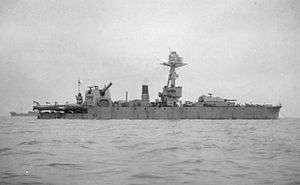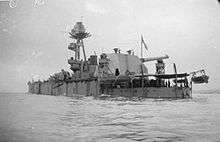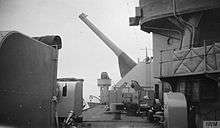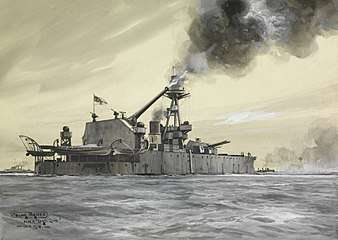HMS Lord Clive
HMS Lord Clive was the lead ship of the British Lord Clive-class monitors. She was named for Robert Clive, 1st Baron Clive, a British general of the Seven Years' War who won the Battle of Plassey and became Governor of British India. Her main guns were taken from the obsolete pre-dreadnought battleship Majestic. She spent World War I in the English Channel bombarding German positions along the Belgian coast. She was fitted with a single 18-inch (460 mm) gun in 1918, but only fired four rounds from it in combat before the end of the war. She was deemed redundant after the end of the war and was sold for scrap in 1927.
 Lord Clive in November 1918, during the surrender of the German High Seas Fleet | |
| History | |
|---|---|
| Name: | HMS Lord Clive |
| Namesake: | Robert Clive, 1st Baron Clive |
| Builder: | Harland and Wolff, Belfast |
| Yard number: | 478 |
| Laid down: | 9 January 1915 |
| Launched: | 10 June 1915 |
| Completed: | 10 July 1915 |
| Commissioned: | 10 July 1915 |
| Decommissioned: | 26 November 1918 |
| Fate: | Sold for breaking up 10 October 1927 |
| General characteristics | |
| Class and type: | Lord Clive-class monitor |
| Displacement: | 5,850 long tons (5,944 t) at deep load |
| Length: | 335 ft 6 in (102.3 m) |
| Beam: | 87 ft 2 in (26.6 m) |
| Draught: | 9 ft 10.5 in (3.0 m) |
| Propulsion: |
|
| Speed: | 7 knots (8.1 mph; 13 km/h) |
| Endurance: | 1,100 nmi (2,040 km) at 6.5 knots (12 km/h) |
| Complement: | 194 |
| Armament: |
|
| Armour: | |
Design
General characteristics
Lord Clive had an overall length of 335 feet 6 inches (102.26 m), a beam of 87 feet 2 inches (26.6 m) including the torpedo bulge, 57 feet (17.4 m) without, and a draft of 9 feet 10.5 inches (3.010 m) at deep load. She displaced 5,850 long tons (5,940 t) at deep load.[1]
Propulsion
She was powered by two four-cylinder Harland & Wolff vertical triple expansion steam engines, which developed 2,310 indicated horsepower (1,720 kW) with steam from two watertube boilers that gave her a maximum speed of 7 knots (8.1 mph; 13.0 km/h) in service. On trials Lord Clive made 8.02 knots (9 mph; 15 km/h). She carried 356 long tons (362 t) of coal which gave her a range of 1,100 nmi (2,040 km) at 6.5 knots (7 mph; 12 km/h).[1]
Armament
Lord Clive mounted two BL 12-inch (305 mm) Mk VIII guns in a single hydraulically powered turret with 100 rounds per gun. Her secondary armament consisted of a pair of 12 pounder guns for which she carried 300 rounds per gun. Her anti-aircraft armament consisted of a single 47-millimetre (1.9 in) Vickers QF 3 pounder Mk I gun with 500 rounds on a high-angle MKIII mount and a 40-millimetre (1.6 in) Vickers 2 pounder Mk I gun on a HA Mk I mount with 1000 rounds. Four 0.303-inch (7.7 mm) Maxim guns were also carried with 5000 rounds apiece.[2]
Wartime modifications


A pair of 6 in (150 mm) guns with 200 rounds per gun were added in early 1916 abreast the funnel when it was realized that the two 12 pounder guns were not powerful enough to defend the ship from German destroyers. They fired 100-pound (45 kg) projectiles at a muzzle velocity of 2,725 ft/s (831 m/s), giving a maximum range of 13,500 yards (12,300 m) at the maximum elevation of 15°. The maximum rate of fire was six rounds per minute. Two coal bunkers were turned into magazines for them, reducing the range to approximately 960 nautical miles (1,780 km), and the crew increased in size to 215, necessitating plating in the sides of much of the upper deck to provide quarters. These guns were replaced by four 4-inch (102 mm) BL Mk IX guns abreast the bridge. They fired a 31-pound (14 kg) projectile at a muzzle velocity of 2,600 ft/s (790 m/s) to a maximum range of 13,700 yards (12,500 m) at a rate of ten rounds per minute. The 12 pounder guns were replaced, probably in 1917, by 3-inch (76 mm) QF Mk I anti-aircraft guns on HA Mk II mounts. They had a muzzle velocity of 2,000 ft/s (610 m/s) with a 16-pound (7.3 kg) shell and had a range of 11,200 yards (10,200 m) at an angle of 45°. They had a rate of fire of twenty rounds per minute and 332 rounds per gun were carried for them.[3]
The biggest change was the addition of a 18-inch (457 mm) BL Mk I gun in an enormous gun shield mounted abaft the engine room, fixed over the starboard side. The gun itself could traverse 20°, but the gun shield was fixed. The entire mount weighed 384 long tons (390 t), but the total weight of the ammunition, equipment and supports nearly doubled this again. This weight so far aft promised to increase the draft at the stern enough that the after inboard compartments of the torpedo bulge, which were normally free-flooding, were closed up, but the ship's draft increased to 8 ft 6 in (2.59 m) forward and 13 ft 2 in (4.01 m) aft. This corresponded to a displacement of 6,850 long tons (6,960 t), even after removal of the armored conning tower in compensation. The gun was hydraulically worked, but the ammunition parties had to use muscle power. The shells were stowed below deck and had to be moved by overhead rail to the hatch in the deck behind the gun to be lifted up and loaded. The cordite propellant charges were kept in eighteen steam-heated storage tanks mounted on the forecastle deck abaft the funnel and moved to the gun on a bogie mounted on rails, two one-sixth charges at a time, reducing the rate of fire to about one round every 3–4 minutes. The interior of the ship was extensively modified to accommodate the larger crew of 278 officers and men, storage and handling gear for the 60 18-inch shells, and to support the weight of the gun mount. Other changes included the transfer of the radio room down into the hold, the addition of a new gyrocompass, enlarging the bridge and rearranging the existing magazines and storage spaces. A pair of two pounder anti-aircraft guns were also mounted on top of the gun shield.[4] The guns had a muzzle velocity of 2,270 ft/s (690 m/s) with a 3,320-pound (1,510 kg) 8 crh armour-piercing, capped shell and had a range of 36,100 yards (33,000 m) at an angle of 45° with a normal charge of 630 lb (290 kg). Using the 690-pound (310 kg) supercharge increased muzzle velocity to 2,420 ft/s (740 m/s) and range to 40,500 yards (37,000 m).[5]
History
World War I: 1915
After Lord Clive finished working up she was sent to the Thames Estuary on 9 August 1915 to practice bombardment techniques with her sisters Sir John Moore and Prince Rupert. A replica had been laid out there of some of the principal features of the Belgian coast near Zeebrugge and the ships practised their manoeuvering and spotting arrangements. Two tripods were dropped in the sea, housing observers which could triangulate the fall of shot and signal corrections to the monitors. One problem was that the modified 12-inch gun mounts broke down quite a bit, as they had not been designed to fire at angles up to 30° and many of their components were quite elderly. The ships were judged ready and a bombardment was planned on 21 August. This had to be postponed for a day because of bad weather, but Lord Clive, her sisters and their supporting armada of ten destroyers, nine minesweepers, the seaplane carrier Riviera, four ships to handle the observation tripods, and no less than fifty drifters to handle the explosive anti-submarine nets laid to protect the monitors, sailed to a position about 10 miles (16 km) off Zeebrugge during the night of 22–23 August. Lord Clive anchored and opened fire at 05:36 on the locks of the Zeebrugge Canal that led to the German naval base at Bruges. She fired 31 shells at the locks over an hour and a half before switching targets to a nearby factory which received eleven rounds. Vice Admiral Reginald Bacon ordered the ships to cease-fire after two hours, cancelling the plans to bombard Ostend as well since both Sir John Moore and Prince Rupert had been suffering significant problems with their turrets. The bombardment was fairly ineffectual; two barges were sunk, some buildings damaged, two civilians killed and some German workmen injured, but the locks were not hit. The British judged this a good first try and planned for a bombardment of Ostend once Sir John Moore and Prince Rupert had been repaired.[6]
The operation had to be postponed for weather several times, but the 77-ship fleet, reinforced by the General Craufurd and the small M15-class monitor M25, was in position on the morning of 7 September. Visibility was excellent everywhere but over the target which was covered by a haze, and Admiral Bacon ordered a withdrawal. German submarines and aircraft attacked as they were leaving, but the monitors took no damage. The monitors returned in the afternoon when the haze cleared and Lord Clive opened fire at 15:30 with a ranging shot on the Ostende lighthouse. However an hitherto unknown battery of four long-range 283 mm (11.1 in) guns began to return fire and soon began to near-miss Lord Clive. She steamed out to sea to open up the range, but her speed was so slow that the Germans had no difficulties compensating for the additional range and she was hit four times in quick succession about 15:50. One hit on the port bulge aft, another alongside the bulge forward, one on the bow and another, that failed to explode, on the starboard two-pounder gun, knocking the gun down to the quarterdeck. Only fourteen rounds were fired by the monitors before Admiral Bacon ordered them to retire, one of which set part of the dockyard on fire.[7]
Another attempt was made on 19 September where the newly arrived monitor Marshal Ney attempted to suppress the Tirpitz Battery with her 15-inch (380 mm) guns, while Lord Clive and Sir John Moore bombarded Ostend from positions thought to be outside the traversing limits of the German battery. This proved not to be the case and she only managed a few rounds before she had to withdraw. On the 25th Lord Clive and several other monitors bombarded German positions at Westende as part of a deception operation to suggest that the Allies were launching an attack in that sector. During the remainder of September and October, she occasionally fired on German coastal batteries. During one of these later shoots Lord Clive's left gun burst when a shell prematurely detonated inside the barrel after the gun liner had deformed from the pressure of the large number of rounds fired.[8]
1916
During December 1915 and January 1916 Lord Clive was stationed in the Thames Estuary to shoot down approaching German Zeppelins with shrapnel shells fired by her main guns, but she was denied a chance to waste ammunition when the Zeppelins never came within range.[9] She bombarded German batteries at Westende on 26 January using the newly developed air-spotting techniques, but she only fired about eleven rounds during the half-hour bombardment. This was the last bombardment for the next seven months as the monitors were used to support British light forces, minefields and net defenses in the Channel. Lord Clive was refitted during this period with a pair of six-inch guns to enhance her armament against German ships. This came in handy on 8 June when she, along with other monitors and destroyers, rebuffed an attempt by a dozen German ships to clear the nets and sweep the minefields. Lord Clive participated in a deception operation on 8 July when she, as well as French 240-millimetre (9.4 in) guns, fired blanks to cover the fire of the brand-new 12-inch Dominion Battery at Adinkerke bombarding the Tirpitz Battery. She was fitted with dummy second funnel to make the Germans think that she was a new monitor. The idea was to deceive the Germans as to the true origin of the shells landing around the battery, but the Germans were not totally deceived and retaliated against the French guns. Shortly afterwards they deployed a smokescreen to hide the battery which hampered spotting and they also located the Dominion Battery and fired against it.[10]
Lord Clive and all of the other monitors of the Dover Patrol simulated preparations for an amphibious landing during the later stages of the Battle of the Somme by firing on German positions at Westende between 8 and 15 September 1916. She fired only 74 rounds during this period as the smaller monitors spent a considerable amount of time acting as offshore aiming marks for the 15-inch monitors. This was the last bombardment of 1916 as the monitors reverted to their role of supporting the Dover Barrage and making anti-destroyer patrols between Calais and The Downs. Lord Clive was given a refit at Southampton during October–November 1916.[11]
1917
Lord Clive was modified in March 1917 to handle one of the enormous 2,500-long-ton (2,500 t) pontoons, in company with Sir John Moore, planned to be used during the Great Landing. Each of the three pontoons was lashed in position between two monitors and could carry a brigade of infantry, an artillery battery and three tanks.[12] The plan was to land each pontoon between Westende and Middelkerke to exploit the Allied gains made during the Battle of Passchendaele and pocket German troops between the landing and the advancing troops. Lord Clive and her sisters rehearsed their role up until mid-July when the battle began. But the Allies could not make the ten-mile (16 km) advance necessary to launch the operation and Field Marshal Haig refused to support Admiral Bacon's proposal for a more modest landing in the Nieuport-Middelkerke area in September, so the operation was cancelled on 2 October.[13]
1918

Lord Clive was drydocked at Plymouth in October and resumed patrols in the Channel before she was taken in hand between 5 December 1917 and 6 April 1918 for modifications to mount the spare 18-inch gun from the large light cruiser Furious, although the gun and mount themselves would not be delivered until 7 September. She bombarded the Tirpitz and Aachen Batteries at Ostend, along with three other monitors, which fired fifty rounds between them during the abortive first attempt to block the Bruges–Ostend Canal on the night of 11 April. She supported the Inshore Squadron during the First Ostend Raid on 23 April with about fifty rounds of 12-inch and some 6-inch shells. Lord Clive relieved Roberts as guardship at Yarmouth for five weeks while the latter was refitted. She arrived at Portsmouth on 16 August to have her 18-inch gun fitted, although it was not shipped until 7 September. She began operational trials with her new gun on 13 October. She fired one round on 14 October at the bridge at Snaeskerke during the morning but received no spotting. She fired another three rounds later in the day but had to cease fire to avoid hitting friendly advancing troops. One round had already been loaded when the order came to cease fire so she fired it, with a reduced charge, into a minefield to seaward.[14]
Peacetime: 1917--1927
Lord Clive was paid off almost immediately after the end of the war and laid up at Immingham. She was towed to Portsmouth in September 1920 to conduct trials with a triple 15-inch gun mount. The Royal Navy had no experience with firing three-gun salvoes from a single turret and wanted to investigate interference between the guns. Her 18-inch gun was removed, along with her secondary armament, and the three guns were installed on the 18-inch mount, covered only by a canvas screen. She recommissioned on 15 December, but she was not ready to conduct the trials until 1 February 1921. She was towed to the Shoeburyness Range for the trials. They revealed no serious problems and she was paid off in August 1921 in Portsmouth. Lord Clive remained there until sold for scrap on 10 October 1927 for £13,500.[15]
References
- Buxton, p. 77
- Buxton, pp. 74, 77, 235
- Buxton, pp. 72–74, 234–35
- Buxton, pp. 73–74
- "British 18"/40 (45.7 cm) Mark I". 22 October 2009. Retrieved 16 November 2009.
- Buxton, p. 54
- Buxton, pp. 55–56
- Buxton, pp. 56–57, 224
- Buxton, p. 57
- Buxton, pp. 58–60
- Buxton, pp. 60–61
- Buxton, p. 62
- Buxton, p. 63
- Buxton, p. 64–68, 74
- Buxton, pp. 68, 76
Bibliography
- Buxton, Ian (2008). Big Gun Monitors: Design, Construction and Operations 1914–1945 (2nd, revised and expanded ed.). Annapolis, Maryland: Naval Institute Press. ISBN 978-1-59114-045-0.
- Gardiner, Robert; Gray, Randal, eds. (1985). Conway's All the World's Fighting Ships: 1906–1921. Annapolis: Naval Institute Press. ISBN 0-85177-245-5.